Investigation of the Wet and Thermal Conditions Effect on the Micro-Scale Characteristics of Interfacial Transition Zone of Porous Asphalt Mixture
Abstract
:1. Introduction
2. Materials and Test Methods
2.1. Material Properties and Gradation Design
2.2. Nanoindentation Test
2.2.1. Sample Preparation
2.2.2. Test Method
2.2.3. Calculation Principle
2.3. BSEM and EDS Tests
3. Test Results and Analysis of ITZ
3.1. Micromechanical Properties
3.2. Micro Morphology Characteristics
3.3. Chemical Element Distribution
4. Conclusions and Findings
Author Contributions
Funding
Institutional Review Board Statement
Informed Consent Statement
Data Availability Statement
Conflicts of Interest
References
- Ma, X.; Jiang, J.; Zhao, Y.; Wang, H. Characterization of the interconnected pore and its relationship to the directional permeability of porous asphalt mixture. Constr. Build. Mater. 2021, 269, 121233. [Google Scholar] [CrossRef]
- Ma, X.; Zhou, P.; Wang, L.; Jiang, J.; Wang, J. Internal structure change of porous asphalt concrete under coupled conditions of load, moisture and temperature. Constr. Build. Mater. 2022, 314, 125603. [Google Scholar] [CrossRef]
- Yu, H.; Zhu, Z.; Zhang, Z.; Yu, J.; Oeser, M.; Wang, D. Recycling waste packaging tape into bituminous mixtures towards enhanced mechanical properties and environmental benefits. J. Clean. Prod. 2019, 229, 22–31. [Google Scholar] [CrossRef]
- Xiao, F.; Herndon, D.A.; Amirkhanian, S.; He, L. Aggregate gradations on moisture and rutting resistances of open graded friction course mixtures. Constr. Build. Mater. 2015, 85, 127–135. [Google Scholar] [CrossRef]
- Wang, X.; Gu, X.; Ni, F.; Deng, H.; Dong, Q. Rutting resistance of porous asphalt mixture under coupled conditions of high temperature and rainfall. Constr. Build. Mater. 2018, 174, 293–301. [Google Scholar] [CrossRef]
- Cui, Y.; Ma, X.; Sun, X. Effects of hydro-thermal coupling on adhesion between asphalt and aggregate. J. Railw. Sci. Eng. 2018, 15, 614–620. [Google Scholar]
- Jiang, J.; Leng, Z.; Yang, B.; Lu, G.; Tan, Z.; Han, M.; Dong, Z. Penetration mechanism of the emulsion-based rejuvenator in damaged porous asphalt mixture: Microstructure characterization and 3D reconstruction. Mater. Des. 2022, 221, 111014. [Google Scholar] [CrossRef]
- Hu, J.; Liu, P.; Huang, Q.; Qian, Z.; Luo, S. Research on interfacial zone failure of asphalt mixture mixed with recycled aggregates. Constr. Build. Mater. 2022, 319, 126113. [Google Scholar] [CrossRef]
- Król, J.B.; Khan, R.; Collop, A.C. The study of the effect of internal structure on permeability of porous asphalt. Road Mater. Pavement Des. 2018, 19, 935–951. [Google Scholar] [CrossRef]
- Asfour, S.; Bernardin, F.; Toussaint, E. Experimental validation of 2D hydrothermal modelling of porous pavement for heating and solar energy retrieving applications. Road Mater. Pavement Des. 2020, 21, 666–682. [Google Scholar] [CrossRef]
- Hu, J.; Qian, Z.; Liu, P.; Wang, D.; Oeser, M. Investigation on the permeability of porous asphalt concrete based on microstructure analysis. Int. J. Pavement Eng. 2020, 21, 1683–1693. [Google Scholar] [CrossRef]
- Brand, A.S.; Roesler, J.R. Bonding in cementitious materials with asphalt-coated particles: Part I–The interfacial transition zone. Constr. Build. Mater. 2017, 130, 171–181. [Google Scholar] [CrossRef] [Green Version]
- Zhu, X.; Yuan, Y.; Li, L.; Du, Y.; Li, F. Identification of interfacial transition zone in asphalt concrete based on nano-scale metrology techniques. Mater. Des. 2017, 129, 91–102. [Google Scholar] [CrossRef]
- Yi, J. Study on Freeze-Thaw Damage Characteristics of Porous Asphalt Mixtures Based on Interfacial Behaviors. Ph.D. Thesis, Harbin Institute of Technology, Harbin, China, 2012. [Google Scholar]
- Yuan, Y.; Zhu, X.; Li, L.; Wang, H. Effect of the interfacial zone on the tensile-damage behavior of an asphalt mixture containing MSWI bottom ash aggregates. J. Mater. Civ. Eng. 2017, 29, 04016269. [Google Scholar] [CrossRef]
- Sicat, E.; Gong, F.; Ueda, T. Experimental investigation of the deformational behavior of the interfacial transition zone (ITZ) in concrete during freezing and thawing cycles. Constr. Build. Mater. 2014, 65, 122–131. [Google Scholar] [CrossRef]
- Wang, L. The Research for Influencing Mechanism of Interface Bonding Property between Asphalt and Aggregate. Master’s Thesis, Hefei University of Technology, Hefei, China, 2016. [Google Scholar]
- Hosan, A.; Shaikh FU, A.; Sarker, P.; Aslani, F. Nano-and micro-scale characterisation of interfacial transition zone (ITZ) of high volume slag and slag-fly ash blended concretes containing nano SiO2 and nano CaCO3. Constr. Build. Mater. 2021, 269, 121311. [Google Scholar] [CrossRef]
- Fu, J.; Xiong, D.; Li, Z.; Ding, Q.; Jia, D. Micron scratch test and parameter analysis of aggregate-asphalt mortar interfacial Transition zone. J. Build. Mater. 2022, 1. Available online: https://kns.cnki.net/kcms/detail/31.1764.TU.20220117.1304.015.html (accessed on 6 February 2023).
- Hu, H. Study on Performance of Recycled Coarse Aggregate Asphalt Mixture and Microscopic Characteristics of Interface Transition Zone. Master’s Thesis, Yangzhou University, Yangzhou, China, 2021. [Google Scholar]
- Li, W.; Xiao, J.; Sun, Z.; Kawashima, S.; Shah, S.P. Interfacial transition zones in recycled aggregate concrete with different mixing approaches. Constr. Build. Mater. 2012, 35, 1045–1055. [Google Scholar] [CrossRef] [Green Version]
- Gao, Y.; Zhu, X.; Corr, D.J. Characterization of the interfacial transition zone of CNF-Reinforced cementitious composites. Cem. Concr. Compos. 2019, 99, 130–139. [Google Scholar] [CrossRef]
- Huang, Q.; Qian, Z.; Hu, J.; Zheng, D.; Chen, L.; Zhang, M.; Yu, J. Investigation on the properties of aggregate-mastic interfacial transition zones (ITZs) in asphalt mixture containing recycled concrete aggregate. Constr. Build. Mater. 2021, 269, 121257. [Google Scholar] [CrossRef]
- Xing, S. Research on Durability of Drained Asphalt Pavement Based on Asphalt Aggregate Interface Theory under Dynamic Water Pressure. Master’s Thesis, Southeast University, Nanjing, China, 2020. [Google Scholar]
- Wang, X.; Gu, X.; Dong, Q.; Wu, J.; Jiang, J. Evaluation of permanent deformation of multilayer porous asphalt courses using an advanced multiply-repeated load test. Constr. Build. Mater. 2018, 160, 19–29. [Google Scholar] [CrossRef]
- Barbhuiya, S.; Caracciolo, B. Characterisation of asphalt concrete using nanoindentation. Materials 2017, 10, 823. [Google Scholar] [CrossRef] [PubMed] [Green Version]
- Karki, P.; Yuya, P.A.; Kim, Y.R.; Turner, J.A. Nanomechanical properties of constituent phases in bituminous mixtures. J. Mater. Civ. Eng. 2016, 28, 4016090. [Google Scholar] [CrossRef]
- Liu, Z. Moisture Diffusion Behavior and Damage Characteristics of Asphalt Mixture within Multi-Scale Domain. Ph.D. Thesis, Harbin Institute of Technology, Harbin, China, 2020. [Google Scholar]
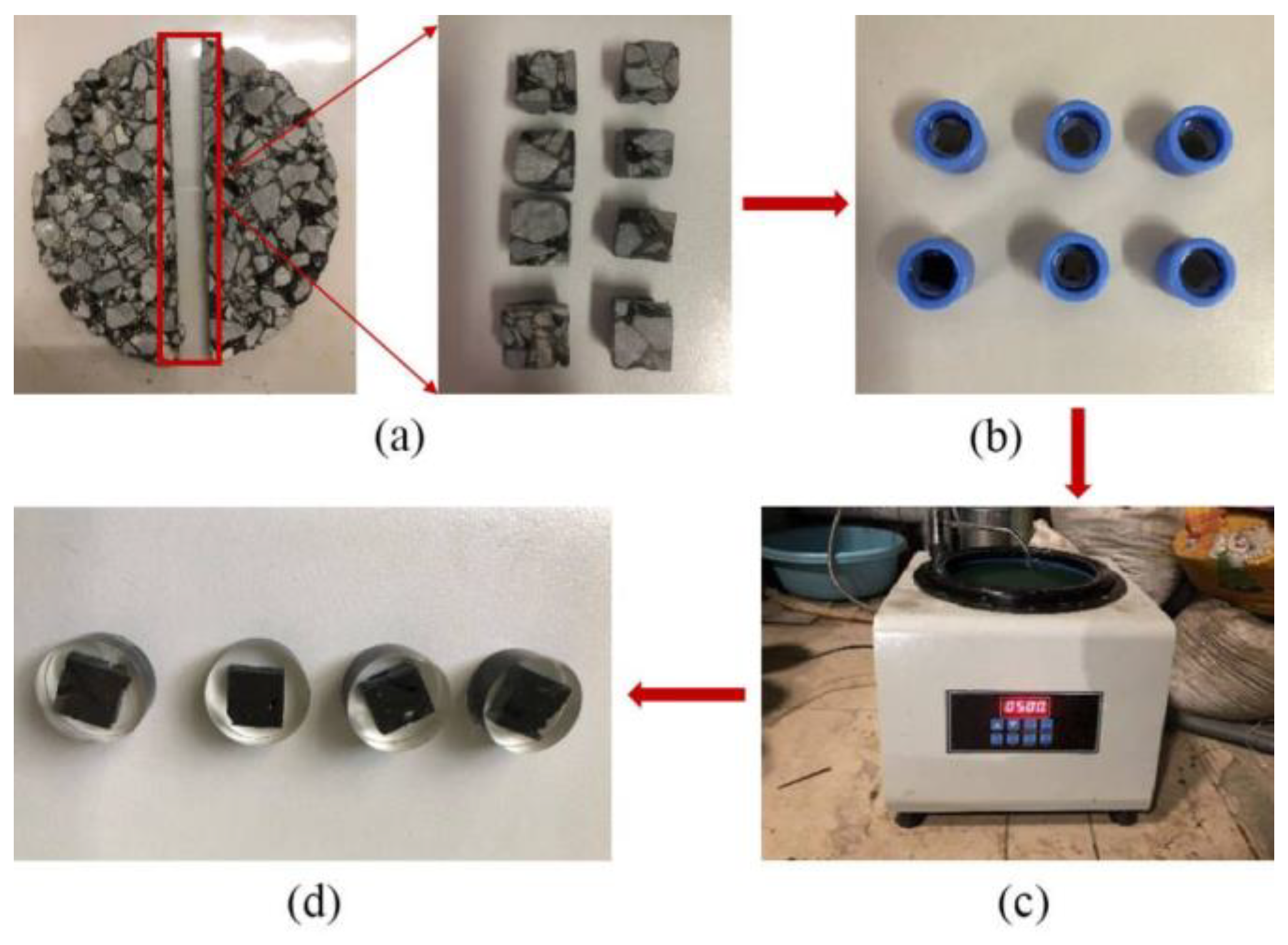
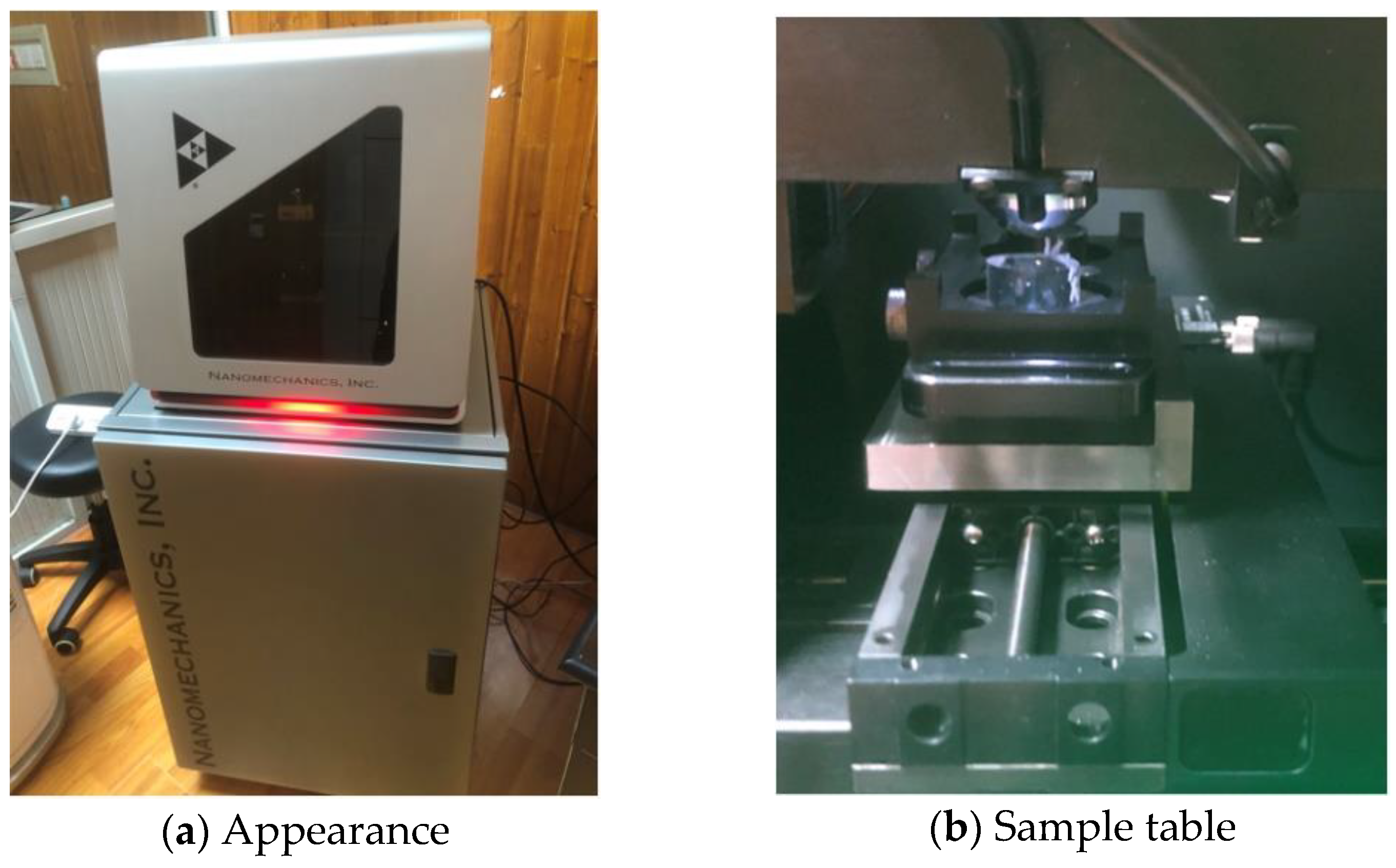
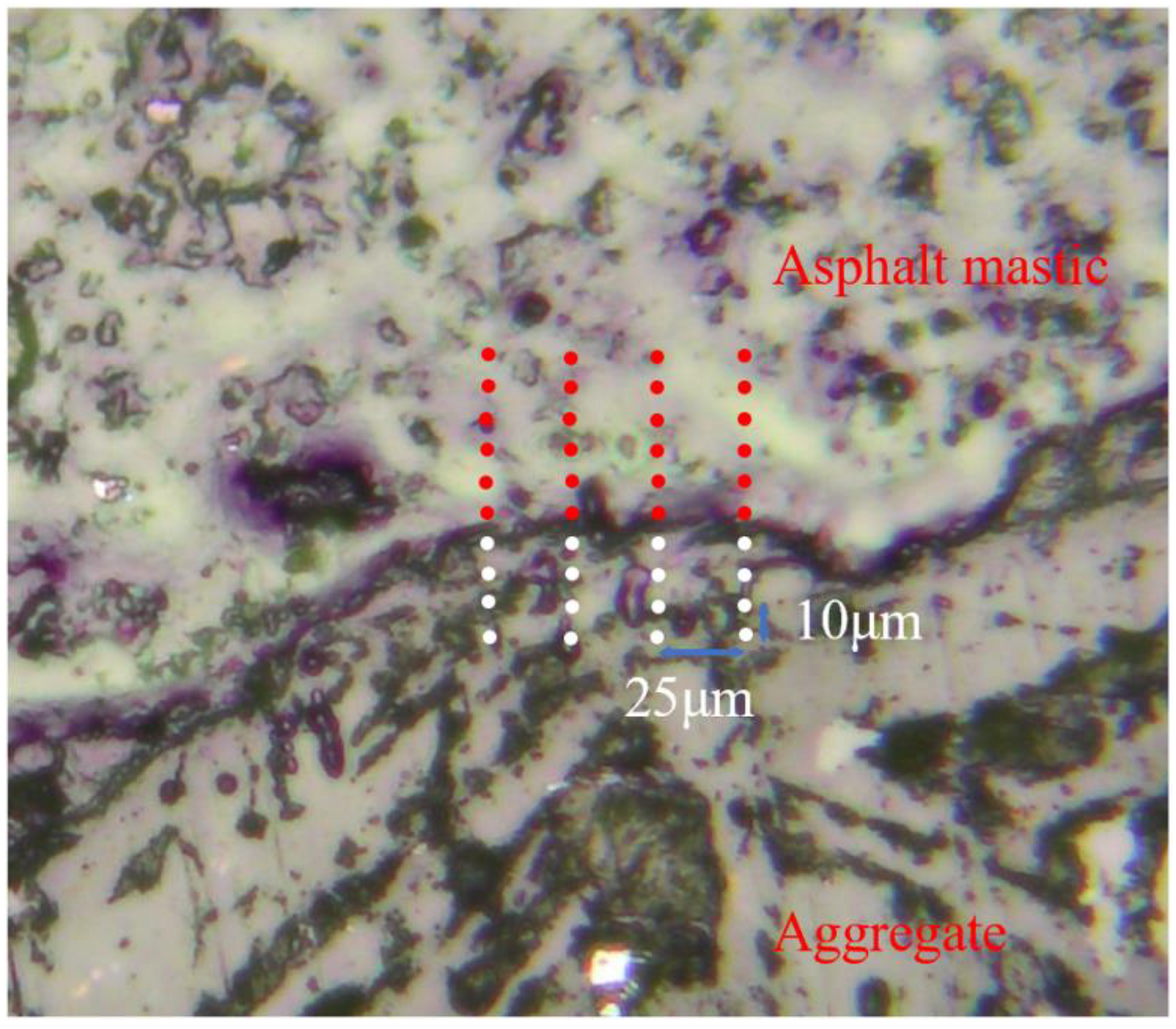
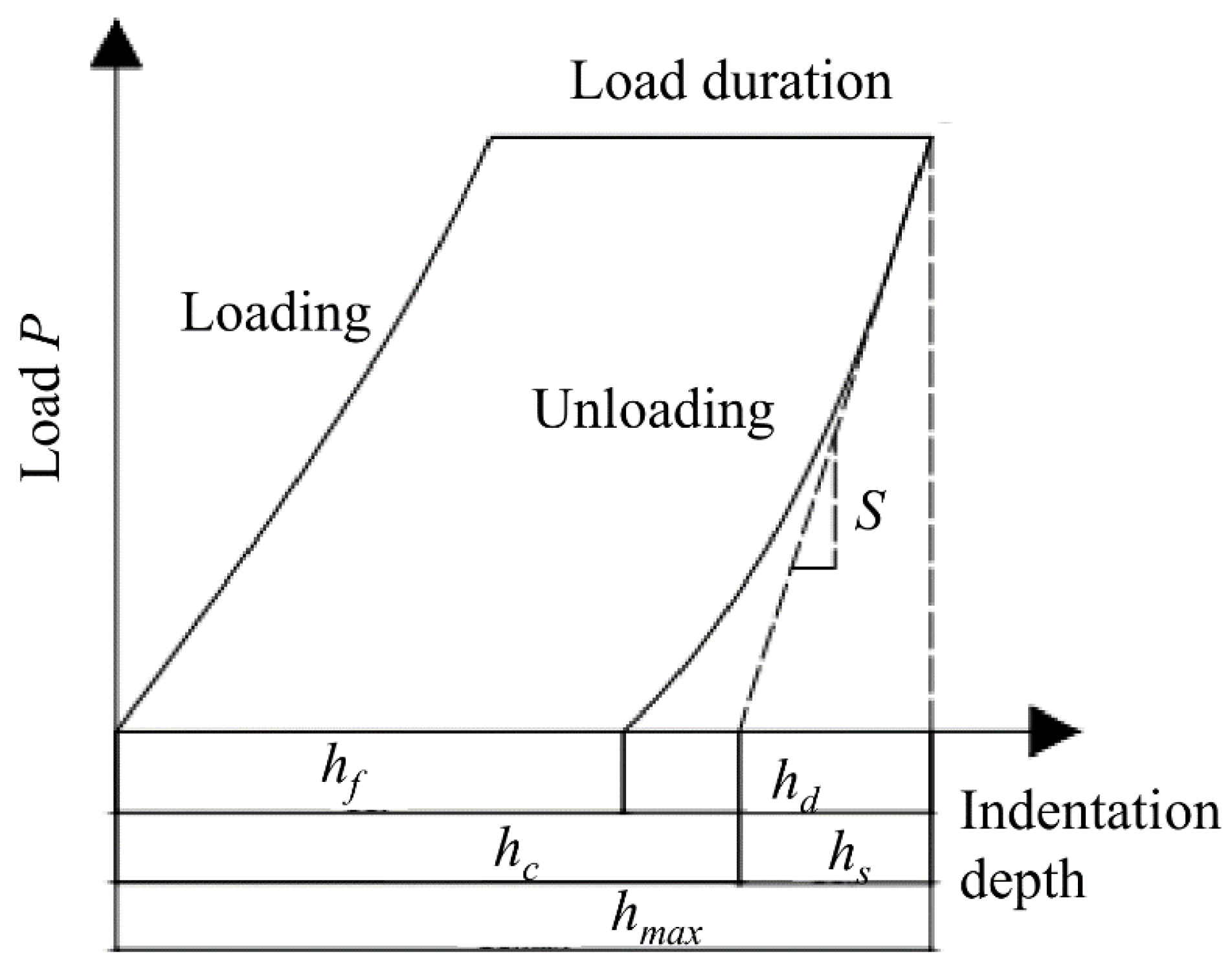
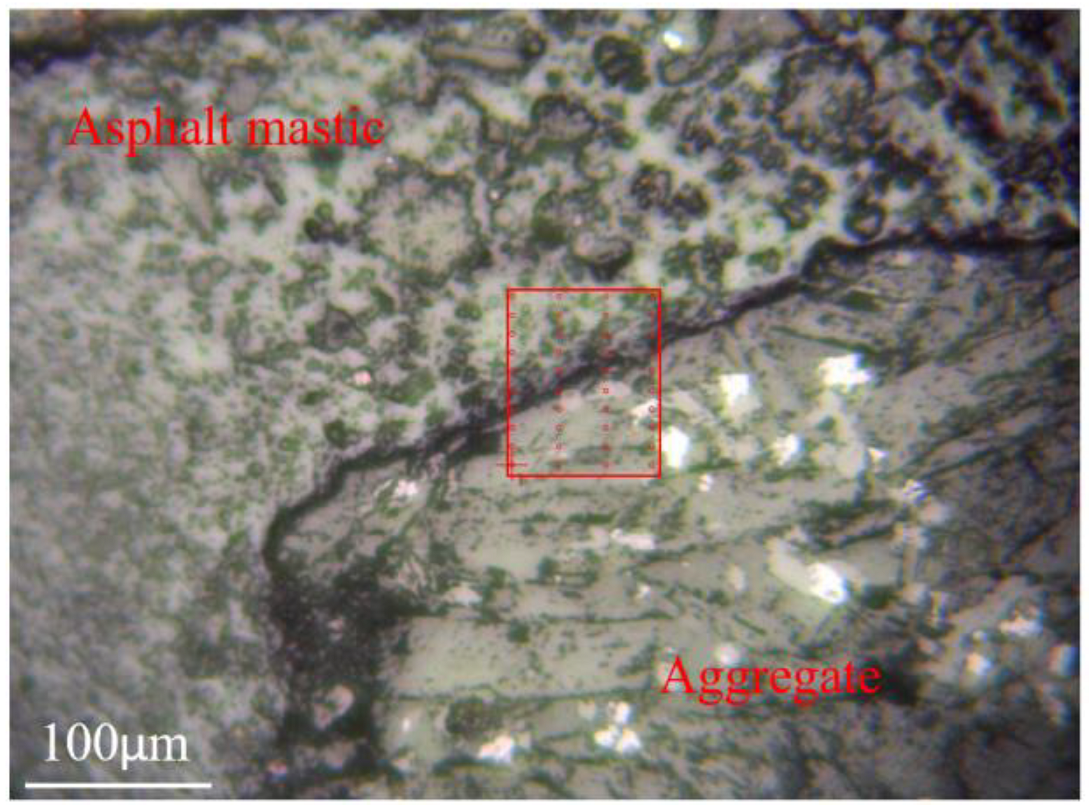
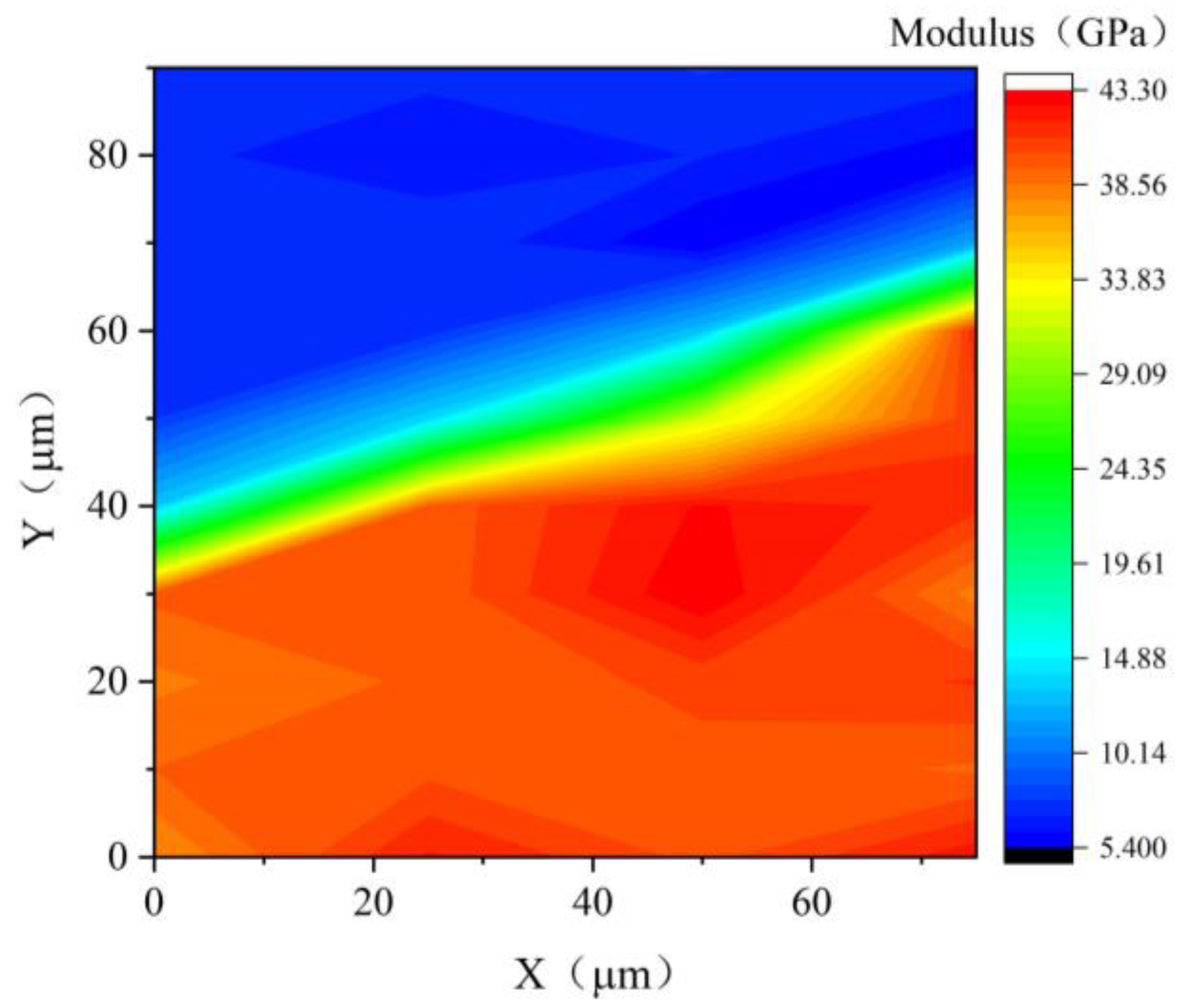



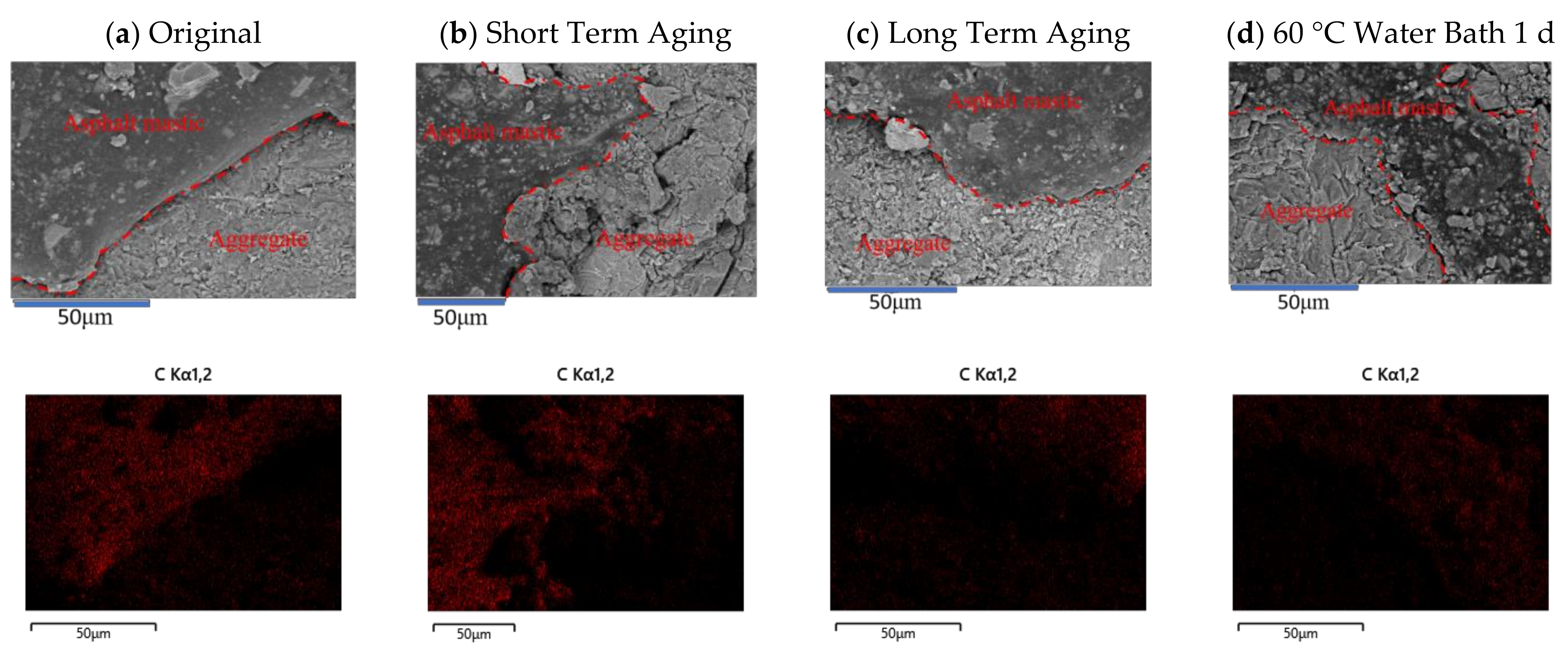
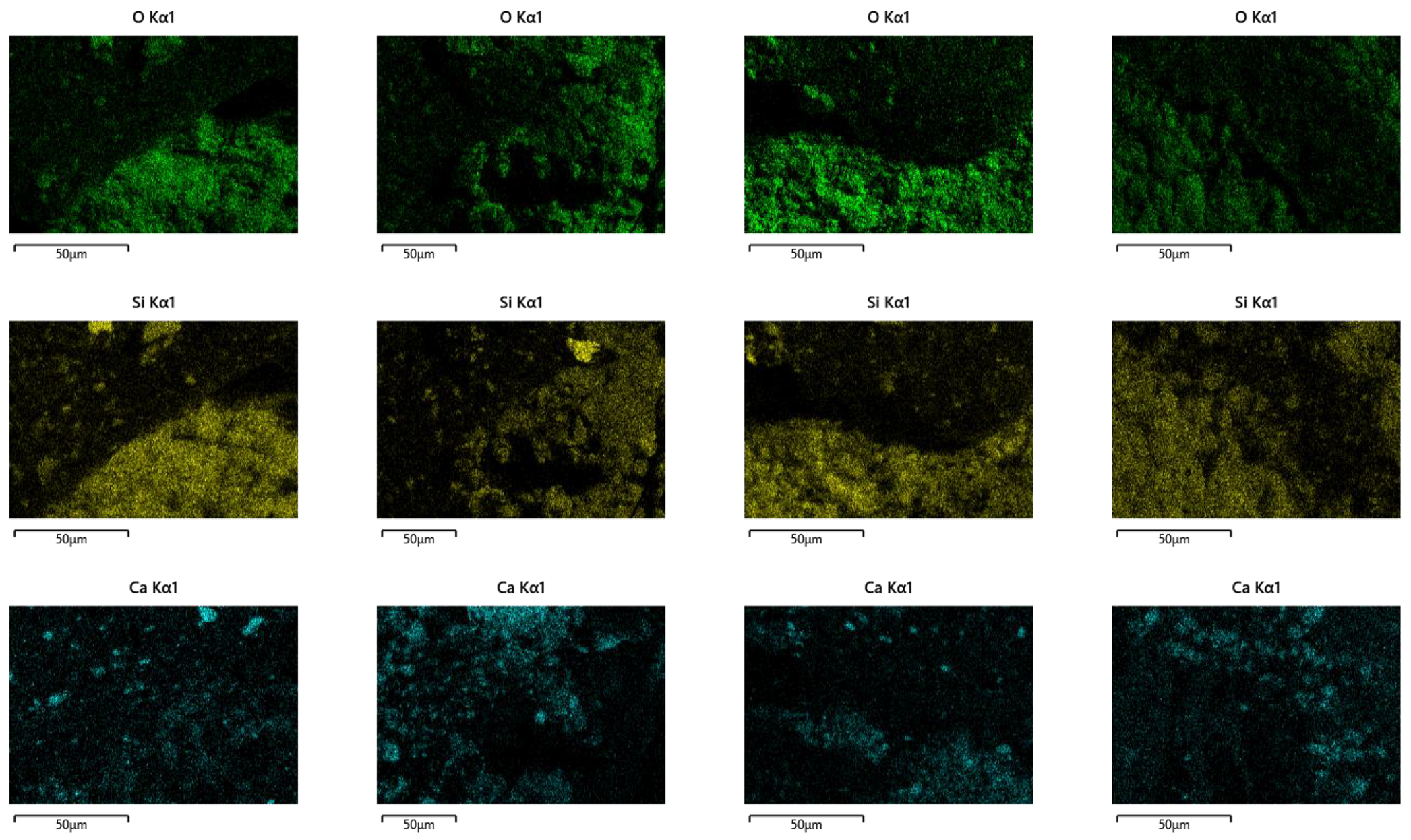

| Technical Properties | Detection Result |
|---|---|
| Penetration (25 °C, 100 g, 5 s)/0.1 mm | 55.5 |
| Ductility (5 °C, 5 cm/min)/cm | 37.5 |
| Softening point/°C | 78.5 |
| Dynamic viscosity (60 °C, Pa·s) | 4841 |
| Mesh Size (mm) | 16 | 13.2 | 9.5 | 4.75 | 2.36 | 1.18 | 0.6 | 0.3 | 0.15 | 0.075 |
|---|---|---|---|---|---|---|---|---|---|---|
| Pass rate (%) | 100 | 92.2 | 60.7 | 20.5 | 14.1 | 11.3 | 7.6 | 6 | 5.3 | 4.6 |
| Project | Original | Short-Term Aging | Long-Term Aging | 60 °C Water Bath 1 d | ||||||||
|---|---|---|---|---|---|---|---|---|---|---|---|---|
| AM | ITZ | BA | AM | ITZ | BA | AM | ITZ | BA | AM | ITZ | BA | |
| Modulus (GPa) | 4.72 | 15.81 | 40.00 | 5.82 | 17.46 | 39.81 | 8.21 | 20.36 | 40.12 | 3.28 | 12.21 | 39.54 |
Disclaimer/Publisher’s Note: The statements, opinions and data contained in all publications are solely those of the individual author(s) and contributor(s) and not of MDPI and/or the editor(s). MDPI and/or the editor(s) disclaim responsibility for any injury to people or property resulting from any ideas, methods, instructions or products referred to in the content. |
© 2023 by the authors. Licensee MDPI, Basel, Switzerland. This article is an open access article distributed under the terms and conditions of the Creative Commons Attribution (CC BY) license (https://creativecommons.org/licenses/by/4.0/).
Share and Cite
Zhao, D.; Ma, X.; Wang, H.; Zhang, C. Investigation of the Wet and Thermal Conditions Effect on the Micro-Scale Characteristics of Interfacial Transition Zone of Porous Asphalt Mixture. Coatings 2023, 13, 566. https://doi.org/10.3390/coatings13030566
Zhao D, Ma X, Wang H, Zhang C. Investigation of the Wet and Thermal Conditions Effect on the Micro-Scale Characteristics of Interfacial Transition Zone of Porous Asphalt Mixture. Coatings. 2023; 13(3):566. https://doi.org/10.3390/coatings13030566
Chicago/Turabian StyleZhao, Dong, Xiang Ma, Hao Wang, and Chaolin Zhang. 2023. "Investigation of the Wet and Thermal Conditions Effect on the Micro-Scale Characteristics of Interfacial Transition Zone of Porous Asphalt Mixture" Coatings 13, no. 3: 566. https://doi.org/10.3390/coatings13030566
APA StyleZhao, D., Ma, X., Wang, H., & Zhang, C. (2023). Investigation of the Wet and Thermal Conditions Effect on the Micro-Scale Characteristics of Interfacial Transition Zone of Porous Asphalt Mixture. Coatings, 13(3), 566. https://doi.org/10.3390/coatings13030566






